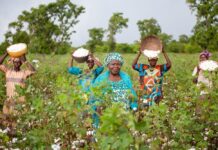Farmers in South Africa are recording loses in crops and livestock due to heavy rains which have resulted in massive in seven provinces due to the effects of La Niña.
South Africa president has since declared a national disaster to handle the worsening situation.
“In agriculture, farmers have suffered crop and livestock losses, and anticipate further losses as the South African Weather Service predicts that current heavy rains will persist,” said the Presidency.
The Presidency said Mpumalanga, the Eastern Cape, Gauteng, KwaZulu-Natal, Limpopo, the Northern Cape and North West had been affected by flooding, which was brought on by heavy rainfall as a result of the La Niña weather phenomenon,” the South African Presidency said in a statement.
Mpumalanga and the Eastern Cape provinces were affected the most.
Elias Sithole, the Head of the National Disaster Management Centre, said deliberating with provincial disaster management centres, and after assessing the magnitude and severity of the impact of the flooding incidents which caused devastating impact in Eastern Cape, Free State, Gauteng, KwaZulu-Natal, Limpopo, Mpumalanga, and North West provinces that resulted in the loss of life, missing persons, damage to property, infrastructure and the environment.
“I classified this occurrence as a national disaster. Emanating from the classification of this occurrence as a national disaster, in terms of section 26 read with section 23(8) of the Act, the primary responsibility to coordinate and manage this disaster, in terms of existing legislation and contingency arrangements, is designated to the national executive,” Sithole said.
The SA Weather Service (SAWS) predicts current heavy rains will persist.
“These conditions were brought on by the La Niña global weather phenomenon which occurs in the Pacific Ocean but impacts on a country like South Africa with above-normal rainfall. Forecasts indicate this weather pattern will remain in place during the early part of 2023. The presence of a La Niña event usually has its strongest impact on rainfall during the mid-summer months. With the continued strengthening of the La Niña event, the country can expect above normal rainfall and below normal temperatures over the summer rainfall areas,” the SA Presidency added.
“These conditions demand provision of temporary shelters, food and blankets to homeless families and individuals and large scale, costly rehabilitation of infrastructure.”








